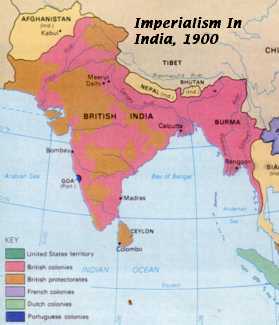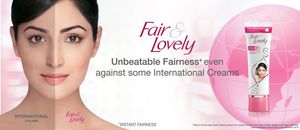Colourism in South Asia
Colourism, also known as shadeism, is the discrimination of an individual based on the colour of their skin, giving preference to lighter skin tones over darker skin, and is a customary practice in South Asian societies.[1] Unlike racial or ethnic discrimination, colourism focuses on the actual physical features of an individual rather than their ethic, social, or geographic identity/affiliation, and often times exists within the same ethnic community.[2] Colourism is a process that systemically privileges light-skinned individuals in areas such as "income, education, housing, and the marriage market"[2] by associating them with positive traits such as intelligence, attractiveness, and competency, whereas dark-skinned individuals are perceived as unattractive, dirty, lazy, and ignorant. [1] Colourism in South Asia, especially in India, Bangladesh, and Pakistan, disproportionately effects women by establishing socialized beauty standards based on the racial superiority or whiteness.[3]
History
Pre-Colonial Perception of Colourism
According to legal professor and Historian at the University of Bangalore, Neha Mishra, pre-colonial India did not discriminate people solely based on the colour of their skin. Indians ranged from all skin tones and were usually bound by their geographic location and hereby there was a historical acceptance of diversity in physical attributes.[4] There was a hierarchy that existed in the form of the caste system but it was not constructed on the basis of colourism. Many heroes and Gods in ancient texts were depicted as dark skinned, and many princesses as well, proving that darkness was not seen as an unattractive trait.[4] This can be seen to be true for many other countries in South Asia, often times the class system in place is falsely interpreted as a depiction of race hierarchy, when in reality it is based off of other factors such as occupation, religion, and geographic location.

Effects of Colonialism on Colourism
The colonial history of Asia has played a significant role in shaping the social hierarchy and construction of race in these nations today. The concept of colourism was based on 19th century colonialism's science of race that considered dark-skinned humans to be innately inferior to light-skinned humans. This conceptualization led to years of slavery and territorial conquest to follow. [5] Due to the embedment of this ideology by colonizers many South Asian cultures associate whiteness with power and prestige. [1]
In the Indian context, when the British invaded Hindustan they referred to the natives as "black coloured" and compared them to animals rather than humans. [4] When the British needed Indian's manpower for their armies and work force they assigned them jobs by giving preference to lighter-skinned Indians over their darker counterparts.[4] The ruling officers of the British Empire made alliances with "light-skinned Indians and gave them extra advantages over the rest of the "blacks"",[4] hereby planting the seed of white superiority within the Indian society. The colonial era shaped the Indian common-man's association of the white coloured skin "with the ruling class, with power, with desirability, and also with beauty". [4]
Impact on Women
Young women of colour are often most "suseptible to sociocultural pressures to achieve unrealistic beautify standards" of fairer skin. [3] According to Sociologist Professor Margaret Hunter, “light skin tone is interpreted as beauty, and beauty operates as social capital for women. Women, who possess this form of capital, are able to convert it to economic capital, educational capital, or another form of social capital”. [2]

Pop-culture and Media
"The ideal of beauty that has been ingrained in the mind of a common man through generations of colonization has been deepened through the fair skinned images all around via the growth of media and popular culture."[1][5]
Colourism is pervasive in "celebrity culture, music, and media where light skin is endorsed and dark skin is erased or vilified" and hereby influences people's belief and attitudes towards it. [3] Images of coloured celebrities or models are often photoshopped or altered to look lighter in magazines and on television. [3] Most actresses and female celebrities in Bollywood are light-skinned and promote skin-whitening cosmetics. In Indian and Pakistani cinema male heroes use words or admiration such as "gori" (fair-complexioned) when referring to their female counter-parts. [5] Often times in Bollywood movies the villain is played by darker-skin tone actors and actresses.[4]
In India many billboards advertising traditional clothing or jewelry have foreign (white-skinned) models rather than Indian models to depict beauty. [4] The ideal standard of beauty for a woman according to the Indian norm is to look like a foreigner--specifically caucasian. Women who do not fit the fairness beauty standard are less likely to be married, and if they are, their family is often required to pay a larger dowry. [1]
Advertisements in India and Pakistan for skin lightening creams and cosmetics take up almost 90% of overall advertisements on PrimeTime TV.[4] Many commercials for one of the most famous and widely-sold brand of whitening creme Fair and Lovely often depicts average women transforming their lives by using the creme. For instance, women are seen being unable to get their dream job or obtain a degree or get married until they start using the product, which makes their skin lighter and hereby makes them successful at all things. [6]
An ethnographic study found that the majority of young women in India use "lightening filters in every photo of themselves before they uploaded them to social media, as they perceived this would make them more attractive and likable". [3] Popular social media applications such as Instagram and Snapchat have a series of different filters that can be used to enhance and lighten skin tone, a function which is very popular amongst adolescent women of colour.
Beauty Products

In many South Asian countries, particularly focusing on India and Pakistan, skin-lightening products represent over half of the entire dermatological market. [3] Fairness solutions "have surged ahead of competing facial skincare product categories over the past ten years" and now claim the largest market share in cosmetics in India. [5] Skin whitening products are marketed heavily in post-colonial countries and constitute a multibillion dollar industry, despite containing many physically harmful ingredients. [2] These products capitalize on women's low self-esteem and cultural perceptions of beauty to exploit the consumers. [1] Due to the adverse effects of these products there have been several movements against them, such as the Dark is Beautiful campaign started by Women of Worth (WOW) organization in Chennai, India.[1]
Career and Education
Dark skinned women in India and surrounding countries have less opportunities in to join the workforce as journalists, sales associates, flight attendants, models, actresses, receptionists and other jobs that "require exposure to and interaction with the public, who will judge [them] as unattractive". [1] There are currently a lack of workplace diversity policies set in place to combat the effects of colourism. [1]
According to studies academic success is also correlated to colourism. Asian women found that "lighter coloured skin was a protective factor against experiences of prejudice and depression, factors which, in turn, may inhibit academic performance". [3] Instances of colourism in educational environments include "preferential treatment by peers and teachers can affect educational outcomes". [3]
Mental and Physical Health Issues
Colourism in South Asian societies heavily impacts the mental and physical health of women, particularly young women between the ages of 18-25. [3] The physical impacts are from the usage of skin-whitening products that contain agents that cause "cancer, thin skin, and damage to the kidneys and nervous system". [1] Research also indicated that skin lightening product usage is correlated with negative mental health outcomes among young adults. [3]
Women with darker-coloured skin in South Asia (and the diaspora) tend to be dissatisfied by their body and image. This dissatisfaction is "associated with negative health outcomes...such as anxiety, depression, eating disorders, and risky weight management behaviours in attempt to change their appearance".[3]
Effects of Colourism in the West
Colourism is not restricted to the Eastern part of the world, it is also prevalent in the West through media, pop-culture, and daily discrimination of dark-skinned women. Hollywood is impacted by colourism because most famous African-American singers and actresses are light-skinned, especially in the case of women. [7] Light skinned black women in the United States are more likely to be married than dark-skinned ones. A study conducted in the US with 12,000 African American women proved that light-skinned women received much shorter sentences than their darker counterparts. [8] This information shows that prejudice against darker-skin tones exists all around the world and it systemically disadvantages women of all races.
Citations
- ↑ 1.00 1.01 1.02 1.03 1.04 1.05 1.06 1.07 1.08 1.09 Sims, Cynthia, and Malar Hirudayaraj. “The Impact of Colorism on the Career Aspirations and Career Opportunities of Women in India.” Advances in Developing Human Resources, vol. 18, no. 1, Feb. 2016, pp. 38–53, doi:10.1177/1523422315616339.
- ↑ 2.0 2.1 2.2 2.3 Hunter, M. (09/01/2007). The persistent problem of colorism: Skin tone, status, and inequality Blackwell Pub. Ltd. doi:10.1111/j.1751-9020.2007.00006.x
- ↑ 3.00 3.01 3.02 3.03 3.04 3.05 3.06 3.07 3.08 3.09 3.10 N., Craddock, Dlova N., and Diedrichs P. C. “Colourism: A global adolescent health concern” 2018. Web.
- ↑ 4.0 4.1 4.2 4.3 4.4 4.5 4.6 4.7 4.8 Mishra, Neha. "India and colorism: The finer nuances." Wash. U. Global Stud. L. Rev. 14 (2015): 725.
- ↑ 5.0 5.1 5.2 5.3 Parameswaran, Radhika, and Kavitha Cardoza. “Melanin on the Margins: Advertising and the Cultural Politics of Fair/Light/White Beauty in India.” Journalism & Communication Monographs, vol. 11, no. 3, Sept. 2009, pp. 213–274, doi:10.1177/152263790901100302.
- ↑ Fair & Lovely Commercial: https://www.youtube.com/watch?v=KIUQ5hbRHXk
- ↑ "Independent Co".
- ↑ The impact of light skin on prison time for black female offenders Department of Sociology and Criminal Justice, Villanova University, Villanova, PA, USA